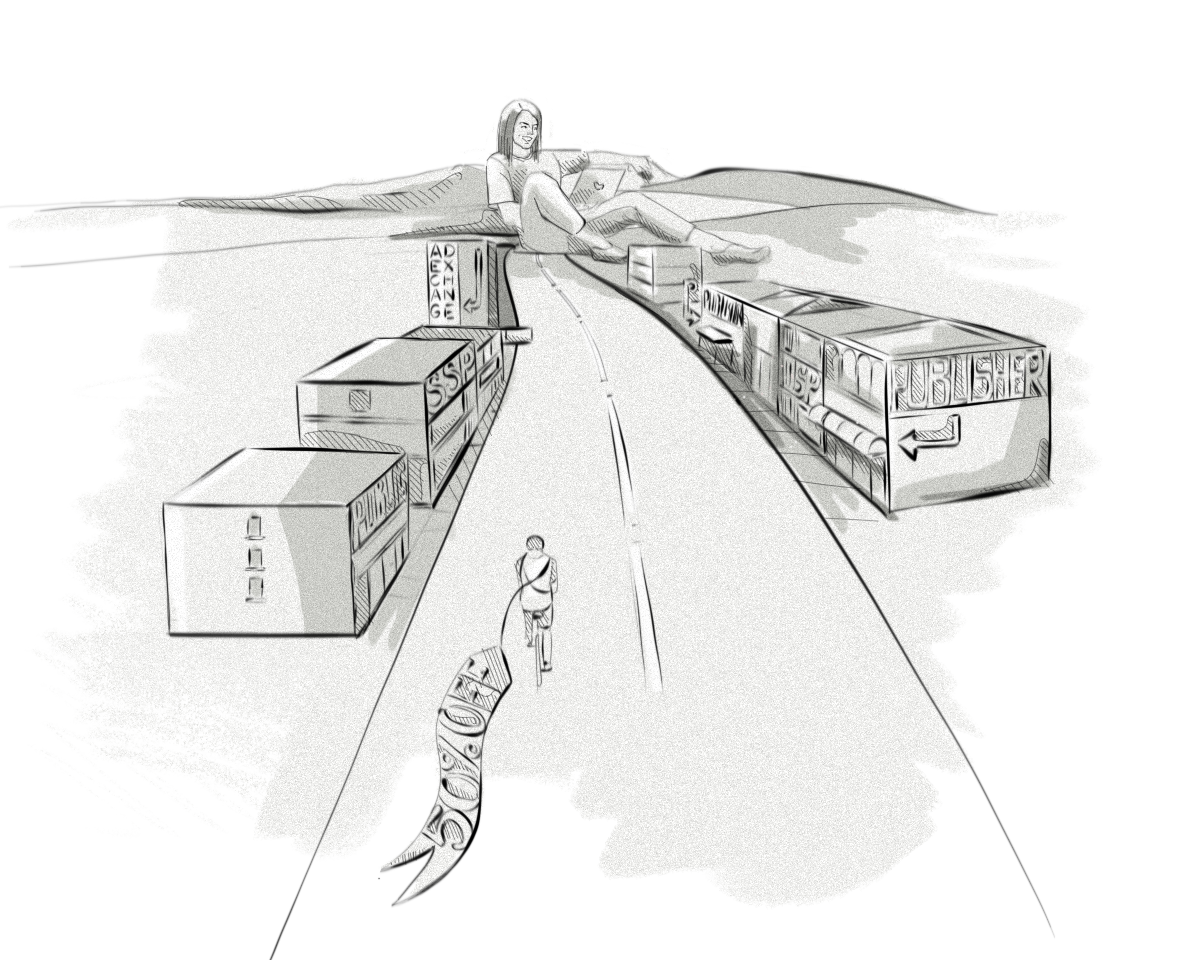Supply-path optimization (SPO) can be compared to a courier service. In the same way a courier has to find the best path to its destination to deliver a package while saving time and money — both its own and the recipient’s — SPO aims to help advertisers find the best route to their desired inventory.
In this article, we will explain what supply path optimization is, where it comes from, why you need it, and how to implement it.
What Is Supply-Path Optimization (SPO)?
In simple words, supply-path optimization (SPO) is the process of finding the shortest and most profitable path to ad inventory for demand-side platforms. Demand-side platforms (DSP) use real-time algorithms to set bids with the shortest and most effective paths to the impressions they want to buy. These algorithms refer to supply-path optimization (SPO). The results of SPO include improving business processes by replacing unprofitable bids with the most optimal ones, while also allowing supply partners (e.g. supply-side platforms and publishers) to receive higher ad revenue at the same time.
But there is more to this process.
Why Should Advertisers and DSPs Adopt Supply-Path Optimization?
The introduction of header bidding provided many benefits, but it also led to bid duplication. During header bidding auctions, advertisers and agencies (via DSPs) started bidding on multiple ad exchanges to increase their chances for getting the right impression. As the popularity of header bidding grew, the number of ad exchanges taking part in these auctions increased and many media buyers spotted some issues, mainly intermediaries who were selling the same inventory across different ad exchanges. Fortunately, AdTech companies saw an opportunity to fix the situation.
Supply-path optimization comes down to recognizing how many intermediaries there are between the DSP and the publisher, as well as how many fees the intermediaries charge, what their max auction timeout is, and what their relationship is to the publisher (i.e. direct or reseller). The strategies of optimization differ — some platforms will aim to pick up the most relevant bid, while others will only look for trusted partners in the supply chain.
In general, SPO helps in identifying duplicated auctions so that DSPs can avoid them. Additionally, it helps to take into consideration the most significant factors that make an auction profitable for the bidder. Therefore, SPO helps to set the best business path for both ends of the supply chain.
We Can Help You Build an AdTech Platform
Our AdTech development teams can work with you to design, build, and maintain a custom-built AdTech platform for any programmatic advertising channel.
How Does Supply-Path Optimization Work?
To leverate SPO, advertisers need to first decide what strategies they want to apply as there are many to choose from. There are many different ways advertisers can optimize their campaigns in the digital supply chain and SPO can be applied to different areas.
To reclaim control and optimize the path to publishers, media buyers can:
- Consolidate the number of SSPs and ad exchanges they work with and only work with a select number of strategic partners.
- Stick to the bids that bring the highest chance of winning.
- Stop buying from the SSPs that don’t allow DSPs to participate in second-price auctions.
- Cut off long-tail SSPs (e.g. resellers).
- Stick to the sellers who offer more exclusive inventory.
The simple rule is that in any auction, a given supply link must bring unique value. That way, you will ensure that every dollar you spend on programmatic advertising is traceable and as impactful as possible.
The Benefits of Supply-Path Optimization
If you are wondering if the only SPO beneficiaries are advertisers, the answer is ‘no’. The entire optimization process is beneficial to all parties in the digital supply chain: advertisers, AdTech companies, agencies, and publishers.
As we said in the intro, optimizing your advertising buying and selling processes can be compared to delivery services. Although the delivery process takes time and some effort, by making optimizations to it, you can end up delivering the package quicker.
With SPO processes you can optimize your media budgets, create new trustworthy partnerships with suppliers, make your supply chain more transparent regarding intermediaries, and improve your campaigns’ performance by analyzing data and gaining new insights. In short, SPO provides benefits connected with revenue, business partnerships, and analysis.
Economic Control
Fees under control. The first benefit of SPO is that you can see what you’re wasting your money on as you might be confused about all the fees charged by all the various SSPs. For example, you may not be aware of discrepancies in the numbers reported by the SSPs and your DSP. However, when you analyze your partners and prune long-tail SSPs, you will have a better understanding of what you are paying for.
Bid shading. Bid shading is an algorithm that analyzes historical bid data to help advertisers pay the lowest among possible for an impression during first-price auctions. Based on the past price of an impression, the ad position, and what price bids were lost at, the algorithm suggests an optimized rate for an impression on their current auctions. By using bid shading, advertisers minimize the risk of overpaying for impressions during first-price auctions.

However, the technology is not so good for publishers as bid shading leaves them with less ad revenue.
Revenue Opportunities
Working with trusted partners who offer you access to quality inventory translates to more revenue opportunities. For advertisers, reducing the number of partners you work with can help you reduce the number of fees you are paying as you won’t be paying fees multiple times for the impression.
For AdTech companies, by reducing the number of SSPs and ad exchanges you work with and only partnering with quality suppliers, you will have the opportunity to attract more valuable clients. Last but not least, the money saved on shady intermediaries will allow you to spend money on developing your tech, for example, by building new features and tools.
Valuable Insights
In the optimization process, you can collect data from the SSPs and ad exchanges you work with. This data will provide you with information about specific details about the auctions, such as whether your bids are getting timed out and whether the auction was a first-price or second-price auction.
However, collecting this data from multiple SSPs and ad exchanges is a resource-intensive operation. Data acquisition, processing, and data storage all cost money. To ensure that you’re collecting the right data and presenting it in a clear and easy-to-understand way, consider building a dedicated reporting dashboard.
Arbitrage Discovery
In May 2017, the IAB Tech Lab released its ads.txt standard (an acronym that stands for Authorized Digital Sellers) to help advertisers and DSPs to recognize certain types of ad fraud (e.g. domain spoofing) and an inventory arbitrage.
Domain spoofing is a process that tricks programmatic advertising platforms into thinking that the ad they’re buying is going to be displayed on a legitimate site (e.g. newyorktimes.com), when in fact the ad will appear on a different site (e.g. fakesite.com). Inventory arbitrage involves buying impressions, repackaging them, and then reselling them at a higher price.
Parties that implemented ads.txt files to their root domains are able to identify unauthorized resellers of a publisher’s inventory and exclude them.
We explain what ads.txt is and how it works in this post.
Supply Chain Visibility
It is hard to get visibility into a supply chain when there are so many parties involved in the process. Falling victim to fraudulent behavior, wasting money on fees, not winning the bids you want — such problems are solved when the chain is shorter and you understand it well.
As in logistics, visibility plays a key role here. Insight into every part of the process provides you with information not only about services but also about the relationships you have with suppliers. Therefore, visibility increases your effectiveness.
In programmatic advertising, a buyer’s supply chain is only as good as their worst SSP. Optimization is effective for advertisers when their ad spend is focused on their preferred partners and no one else.
SPO’s Benefits For Advertisers
One of the main advantages of SPO is getting rid of the bid duplication issue. As a result, media buying is more transparent and efficient.
Insights into the supply chain. SPO provides you with information about which SSPs and ad exchanges are supplying you with ad inventory, what you’re paying for the impressions, etc. With this data, you can make the right optimizations and make better business decisions.
Brand safety. Ads displayed on inappropriate pages are still a problem for advertisers and affect their brand image. By implementing SPO mechanisms, you can exclude suspicious suppliers who do not care about your brand safety criteria.
Greater transparency for business. Simplifying the supply chain is an obvious benefit of SPO. By analyzing each stage, from auction participation to the final impressions, you get valuable information about your business partners — both the good and the bad.
SPO’s Benefits For Publishers
All the benefits for advertisers will also have a positive effect on publishers because in the AdTech industry, the vessels are connected. SPO provides benefits for both ends of the digital supply chain, especially when it comes to profits.
Advertisers will change their spending strategy: SPO means that intermediaries who do not bring any value will be excluded from the delivery path. So, the publishers who offer premium inventory will receive more direct paths to advertisers and earn more ad revenue.
More profits: Publishers who care about the quality of their audiences and relationships with buyers are more competitive and will attract more ad dollars.
Improving the overall quality in the market: SPO means that low-quality or shady publishers and resellers will aim to improve the quality of their offer or face extinction. This, in turn, means that the overall market will change for the better.
How Can You Implement SPO?
SPO is a continuous, iterative activity. The steps of the process described below will help you implement it.
- Internal assessment
To start SPO, you need to understand what is important for your business’s development and what contributes to your success. Calculating your ad spend across SSPs and publishers is essential. Ask yourself the questions related to:
- The amount of SSPs and ad exchanges you use to buy inventory.
- Where the impressions are coming from.
- The number of intermediaries you believe you are paying fees to.
- SSP evaluation
As we said, picturing the place where your ad-buying activities are now is your first step. However, before contacting your current partners, you should know what strategy you want to run. Based on your strategy, you will build the evaluation criteria and be able to start the evaluation process. The differences between SSPs will also help you determine a standardized Request for Information (RFI) process.
- SSP consolidation and testing scenarios
An important part of designing your SPO strategy is to look at the SSPs you are using, although most allow you to turn SSPs on and off or choose your preferred SSPs. So what do you need to do to make SPO successful? The third step is to prepare comprehensive test scenarios whereby you test the various SSPs and ad exchanges you work with to see if there are any issues related to campaign performance and to ensure the integrations are working properly.
- Further optimization
As we mentioned before, optimization is an ongoing process. Therefore, the best move is to look at the delivery paths and evaluate them in terms of your current purchasing strategy — preferably several times a year. Remember, however, that both the advertising industry and all companies operating in this market change over time.
The Summary
Supply path optimization may seem to be an action that provides value only for advertisers, but it also benefits publishers. SPO’s algorithms teach themselves to execute the programmatic advertising strategy you’ve developed. But the first step you need to take in order to implement them is to analyze your current position. Then you can work out the strategy, apply it and reap the benefits it provides.
We Can Help You Build an AdTech Platform
Our AdTech development teams can work with you to design, build, and maintain a custom-built AdTech platform for any programmatic advertising channel.








